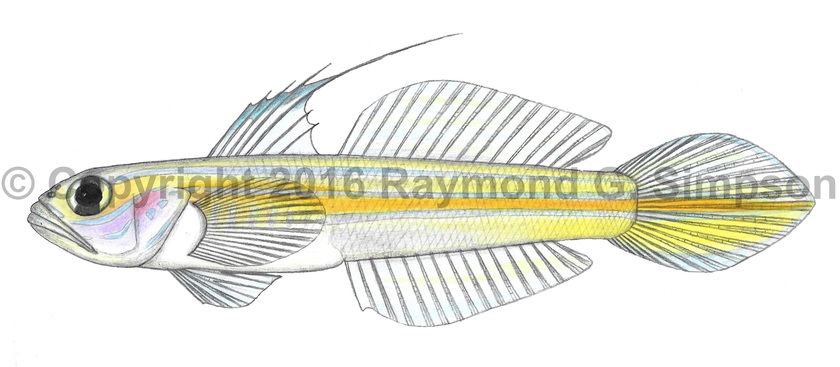
Common Name
Seminole Goby
Year Described
Fowler, 1945
Identification
Dorsal Fin: VII, 15-18 (usually 16-17)
Anal Fin: 16-19 (usually 16-17)
Pectoral Fin: 20-24 (usually 21)
Gill Rakers: 5+15
Scales: 50-62 rows
Body elongate. Mouth large and upturned. Dentary with 4-5 teeth. Dorsal crest absent in both sexes. There are two preopercular pores. Supraorbital canals usually separate. Dorsal spines 2-5 elongate in males but not elongate in females. Body covered in mostly ctenoid scales.
Color
Body translucent to opaque with a lateral yellow stripe running from upper opercular edge to the tail. Yellow stripe is bordered with blue on both sides. A second blue stripe runs from the upper eye along the upper body to the caudal peduncle. Area between stripes yellow on the rear body. Gut is white. Cheek purplish to red with 2-3 transverse iridescent blue stripes (sometimes broken into segments). Eye white with a median dark band. Spiny dorsal clear with a aqua hue on the distal edge. Soft dorsal and anal fins clear with faint yellow stripes. Tail with a continuation of the body stripe, a yellow lower lobe, and a blue upper margin. Pelvic fin pale blue. Pectoral fin clear.
Size
Maximum size to 75mm SL.
Habitat
Over coarse sand bottoms from 6-21m.
Range
Florida to Tobago, including the Gulf of Mexico and the Caribbean Sea.
References
Birdsong, R.S. 1981. A review of the gobiid fish genus Microgobius Poey. Bulletin of Marine Science v. 31 (no. 2): 267-306.
Tornabene, L. , J.L. van Tassell and D.R. Robertson. 2012. Microgobius urraca (Teleostei: Gobiidae), a new species of goby from the tropical eastern Pacific. Zootaxa No. 3447: 41-55.